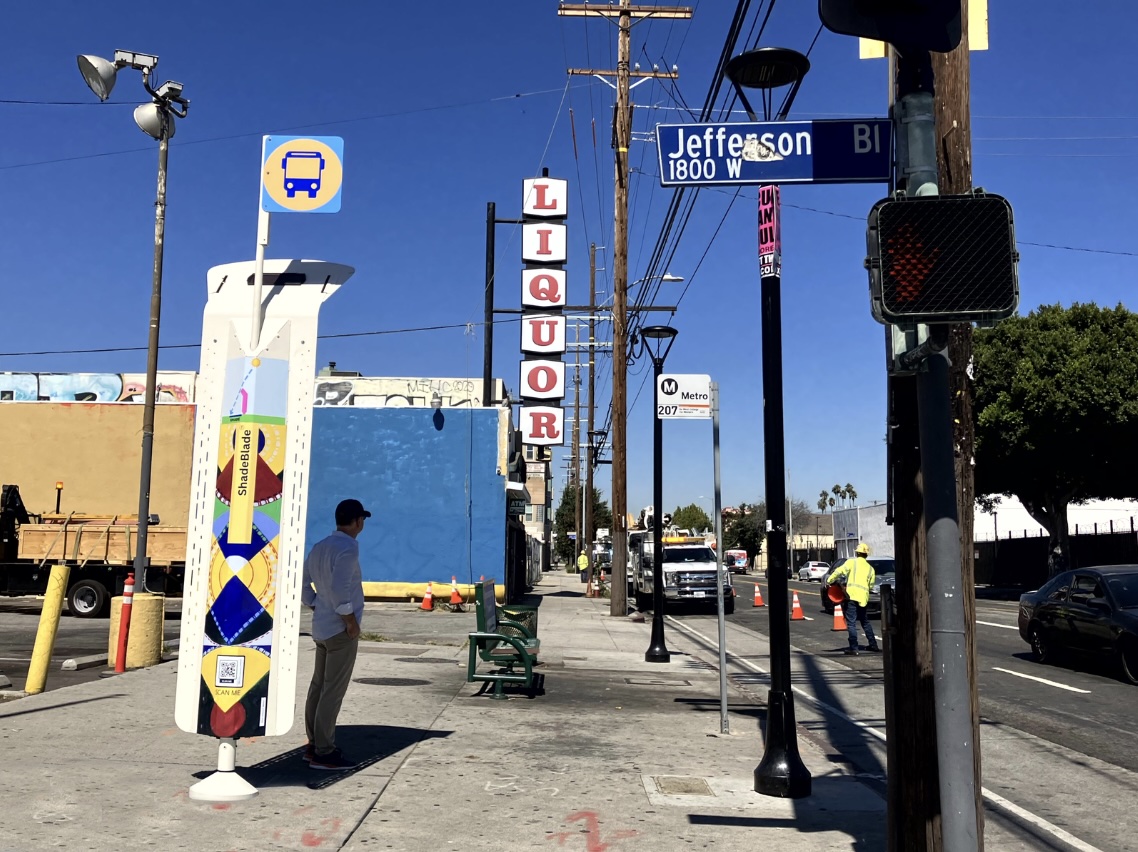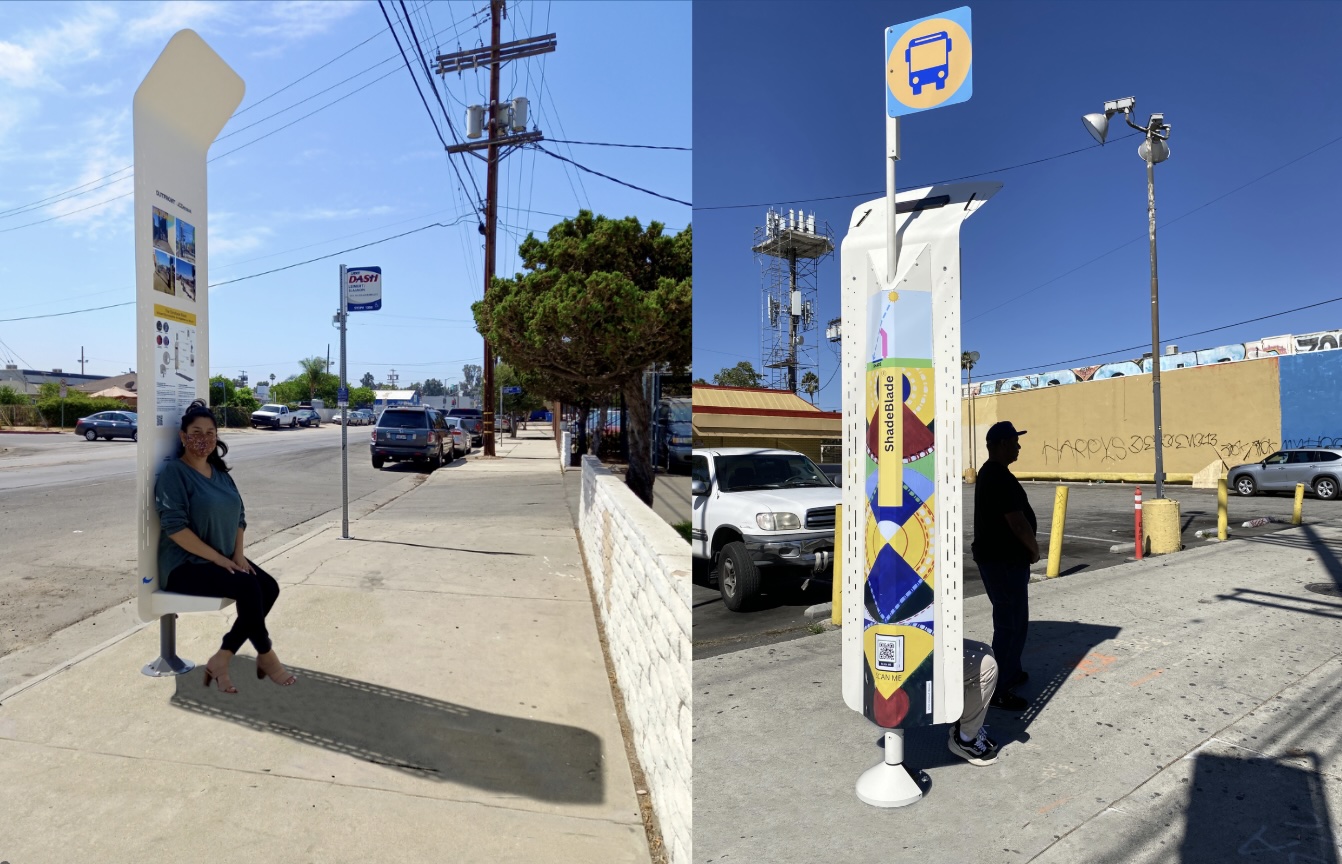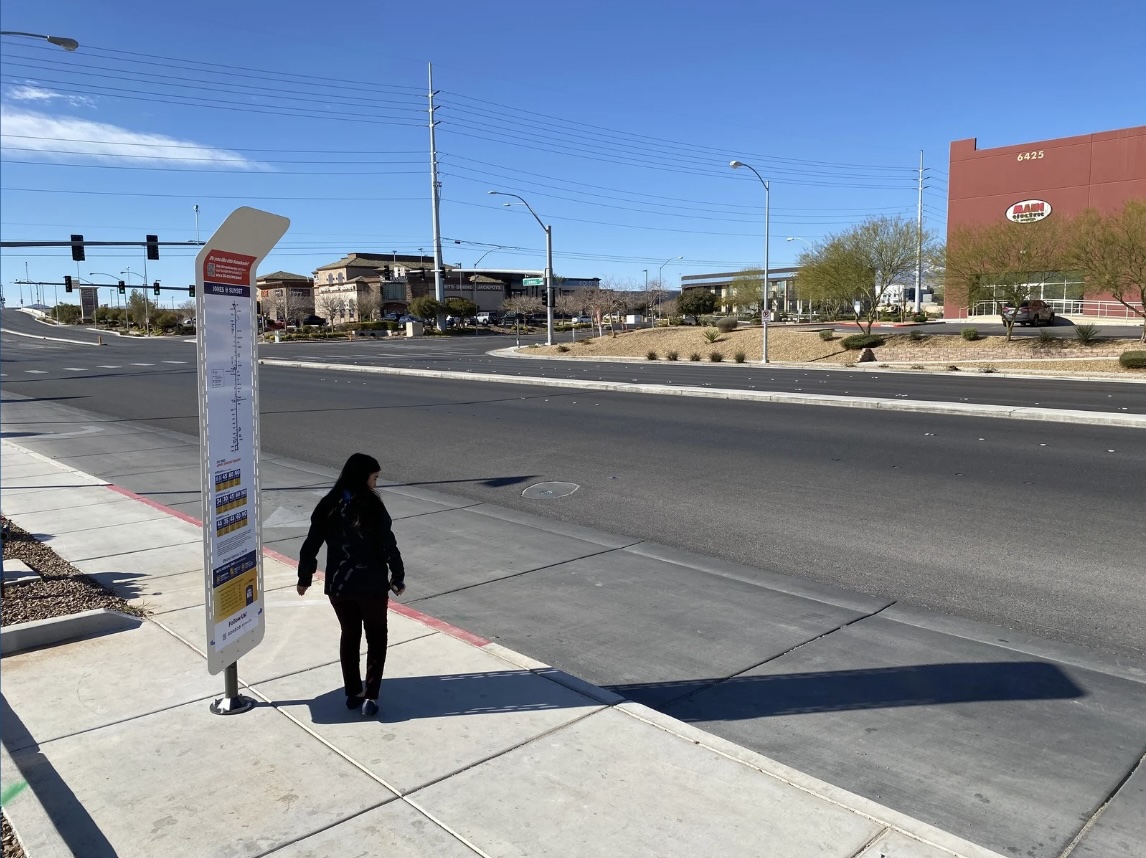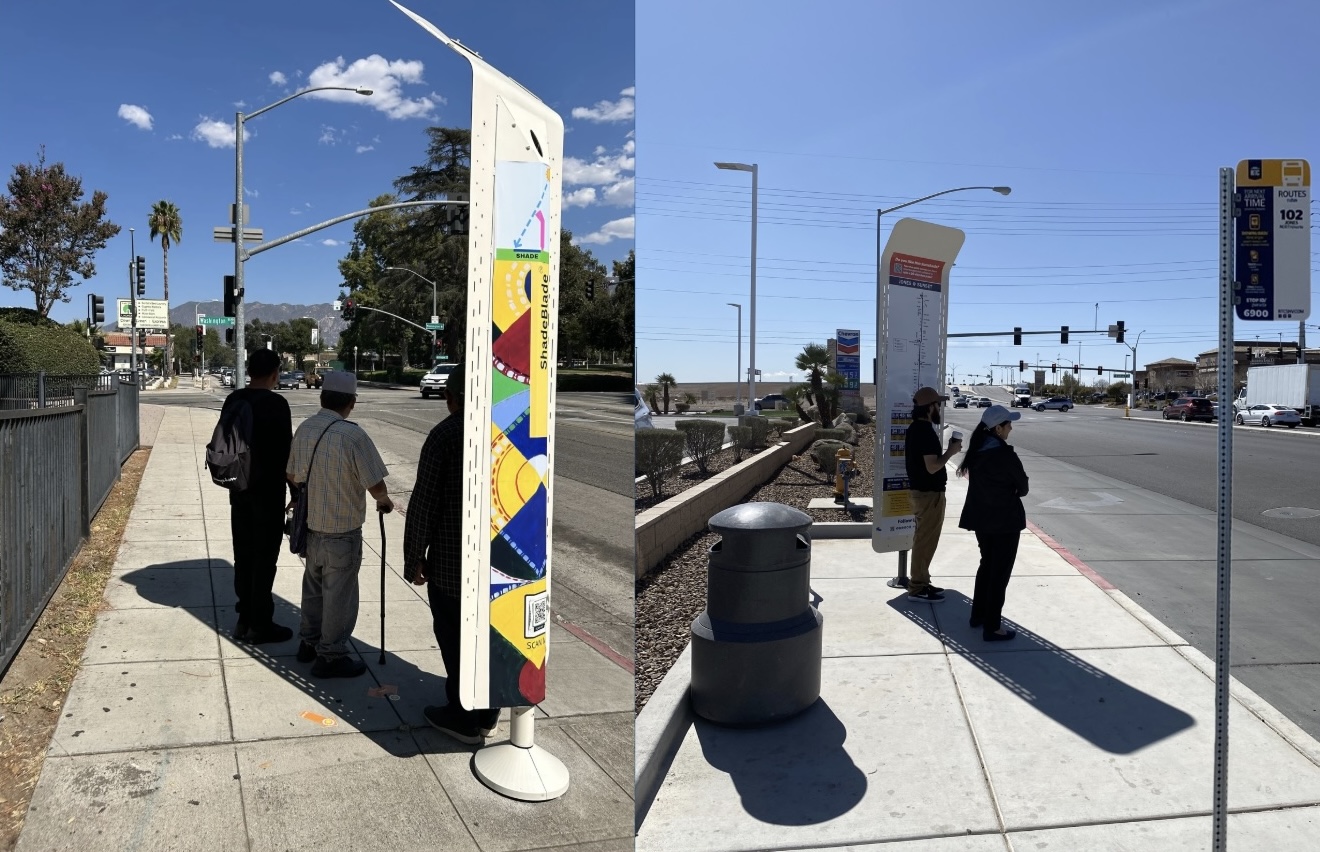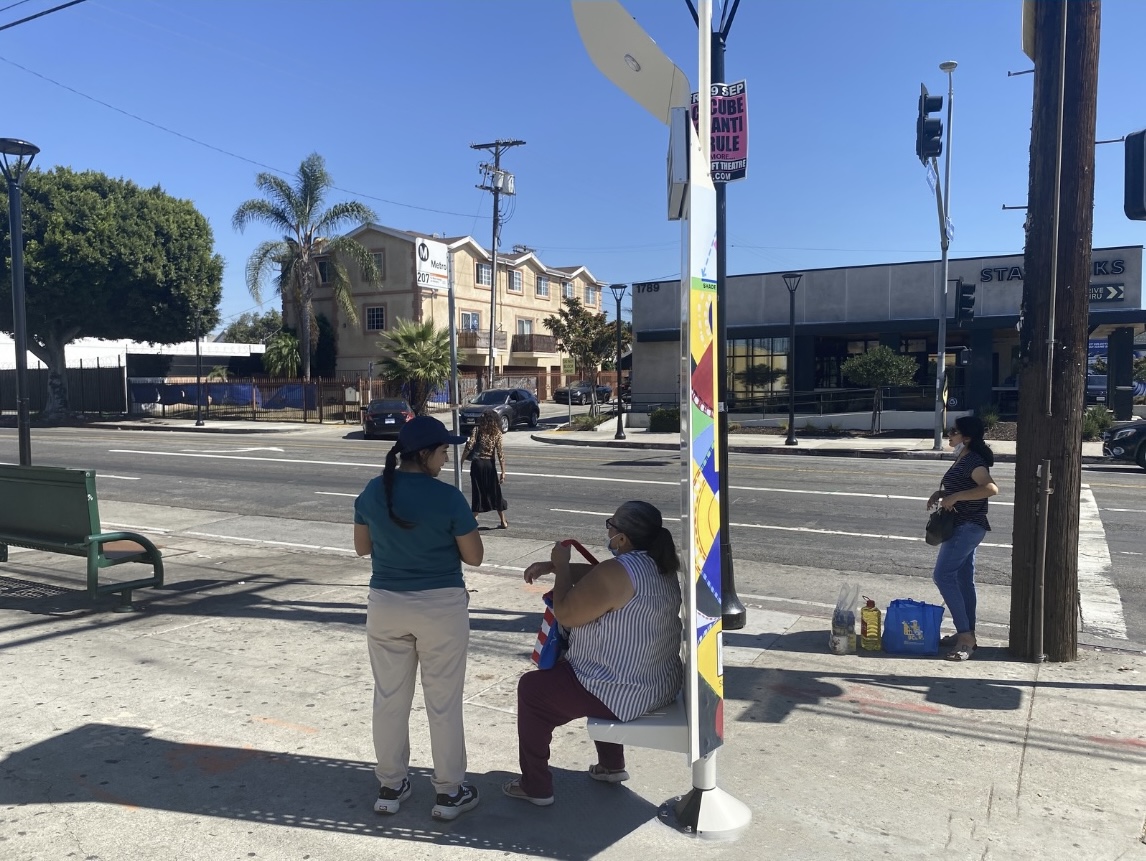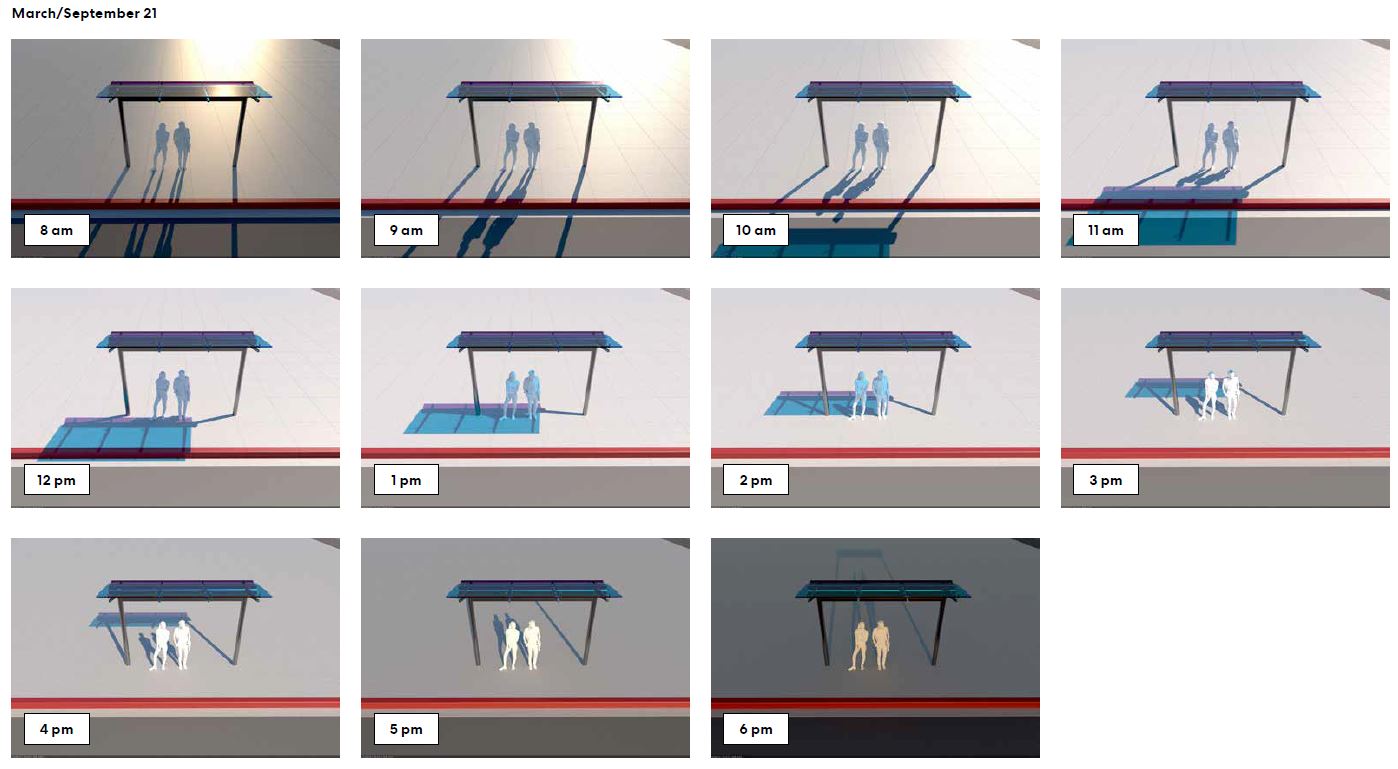80% of bus stops served by 16 of the nation’s largest transit agencies don't have shelters
The Washington Post, 2022Transit riders face major health risks related to extreme heat and direct UV exposure from the sun, while waiting at bus stops.
Urban climate adaptation measures are essential to protect transit riders from excessive direct heat and UV exposure. It is imperative to create useful shade at bus stops to ensure the well-being of passengers at every bus stop, all day.
What is a ShadeBlade™?
A new transit amenity intentionally designed for transit riders, it provides constant shield and shade from the sun at all hours of the day.
The ShadeBlade is a vertical, opaque structure that easily rotates and can follow the sun creating useful shade for transit riders at bus stops.
Video Transcript
ShadeBlade bus stop shade structure providing sun protection for transit riders in Southern California.
Shade Travels with the Sun
A push-to-rotate system creates personalized useful shade for transit riders at bus stops.
Public transit
and
user benefits
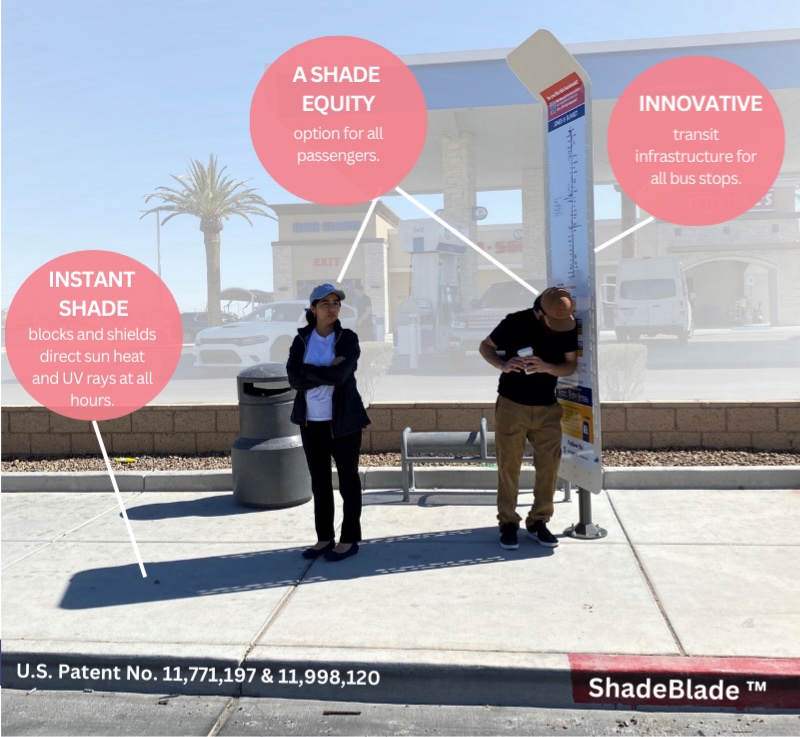
A Smart Transit Innovation
The ShadeBlade comes with a kit of parts to improve the transit rider waiting experience, such as seating, lighting and more!
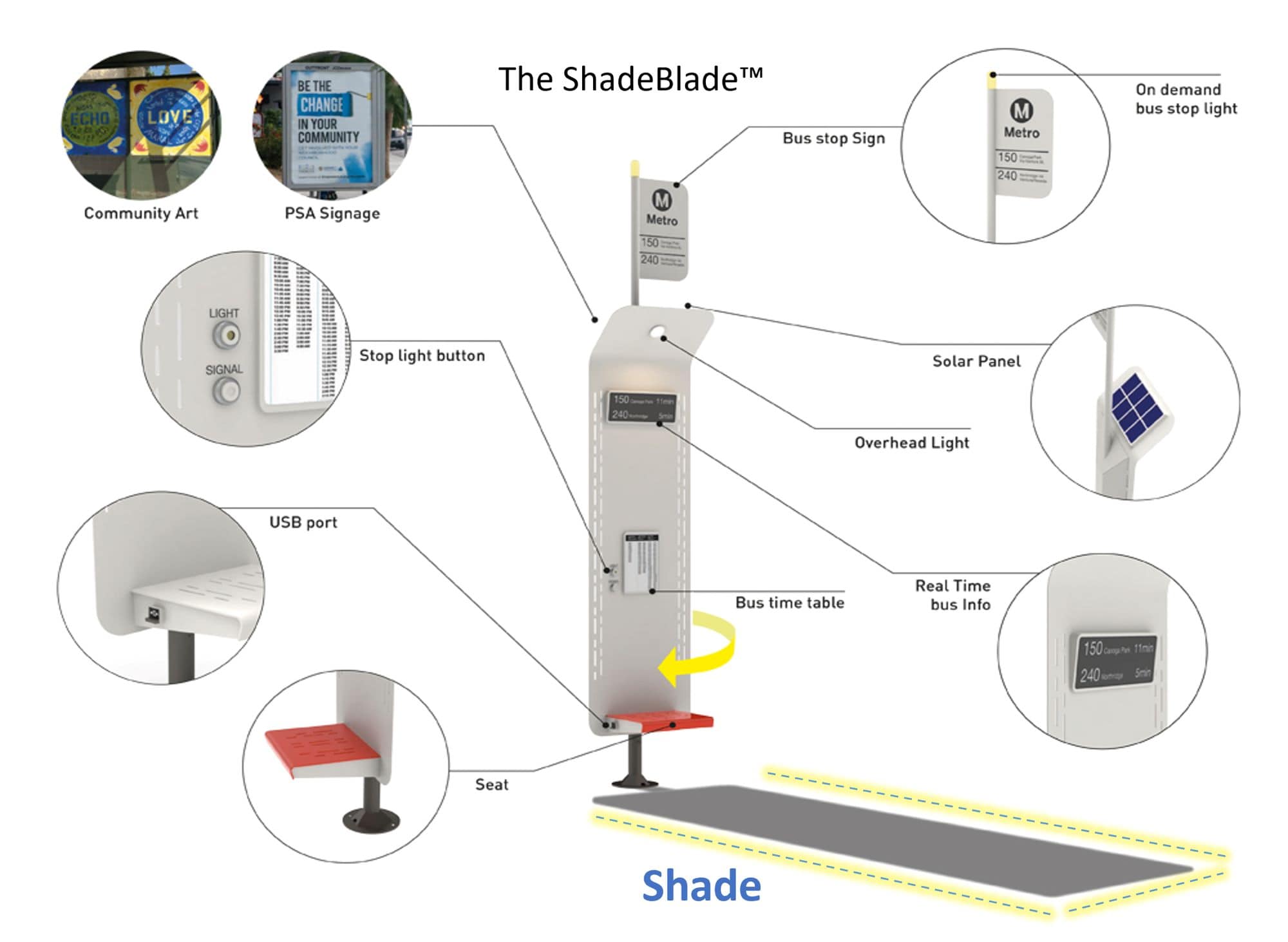
The ShadeBlade works in collaboration with shade equity efforts.
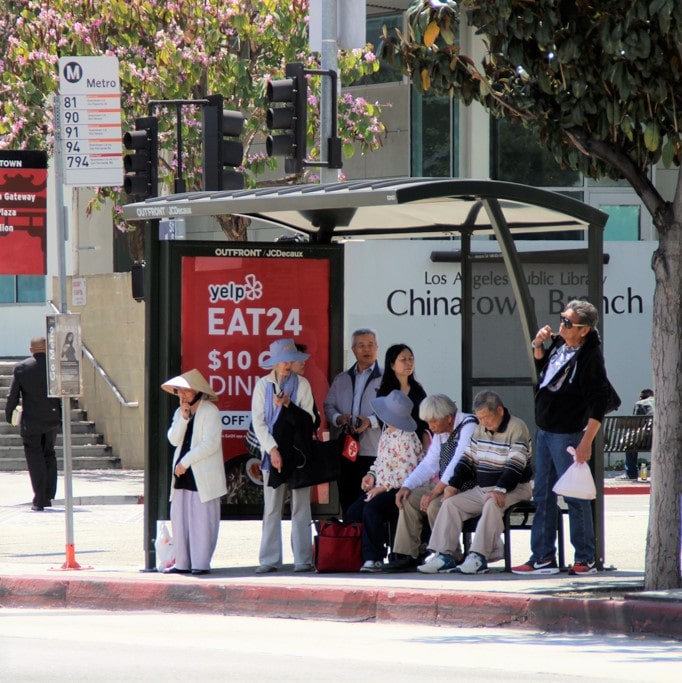
Traditional Bus Shelters
Effective for bus stops with multiple riders at the hottest hours of the day. Approximately 80% of bus stops do not have one at all. We must consider alternative options to provide access to useful shade all day. .
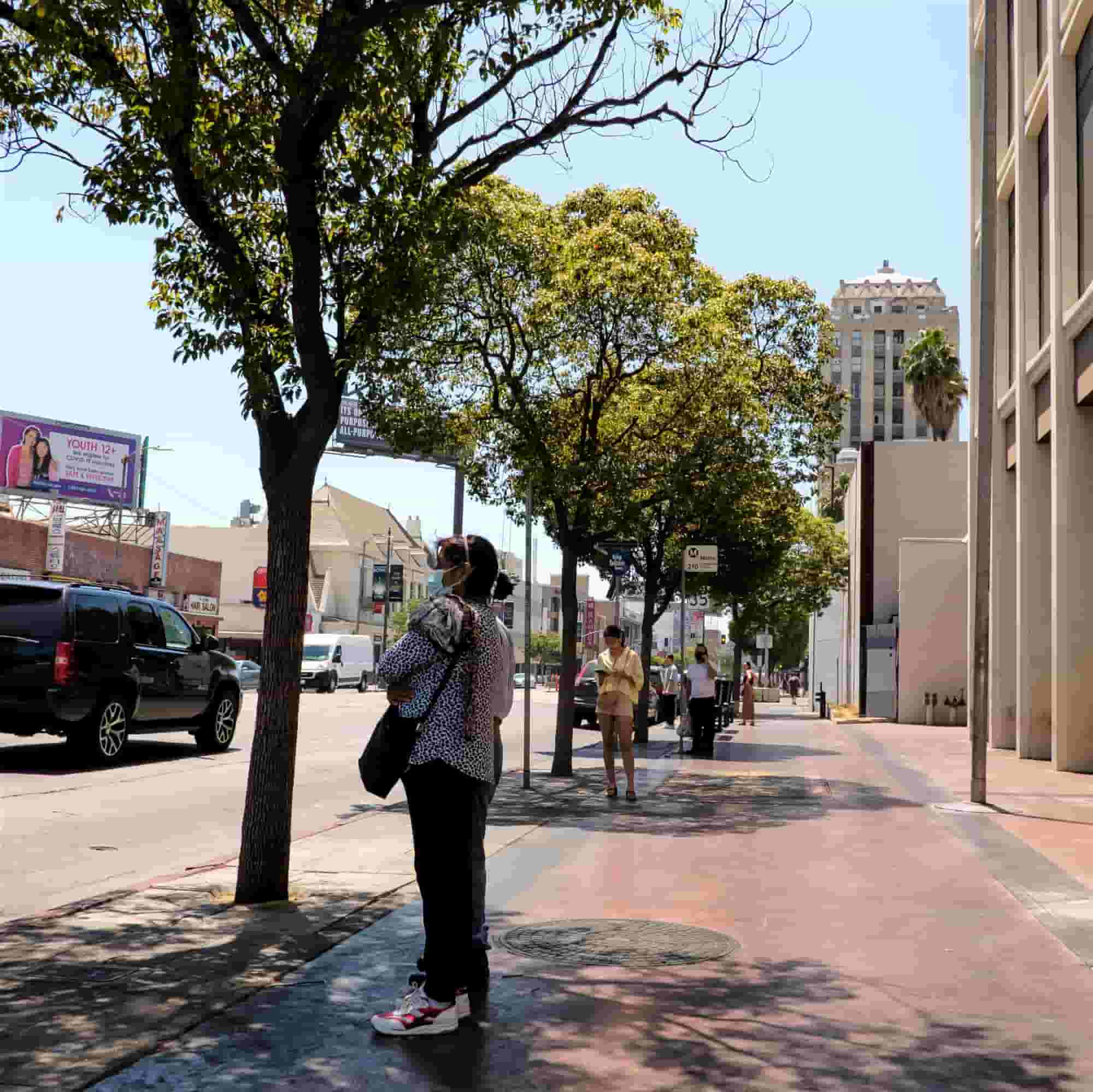
Trees
Tree initiatives are ideal and a long-term solution to provide natural cooling and fight the effects of urban heat islands. The maintenance, location, sidewalk, and age of trees need to be considered at each bus stop.
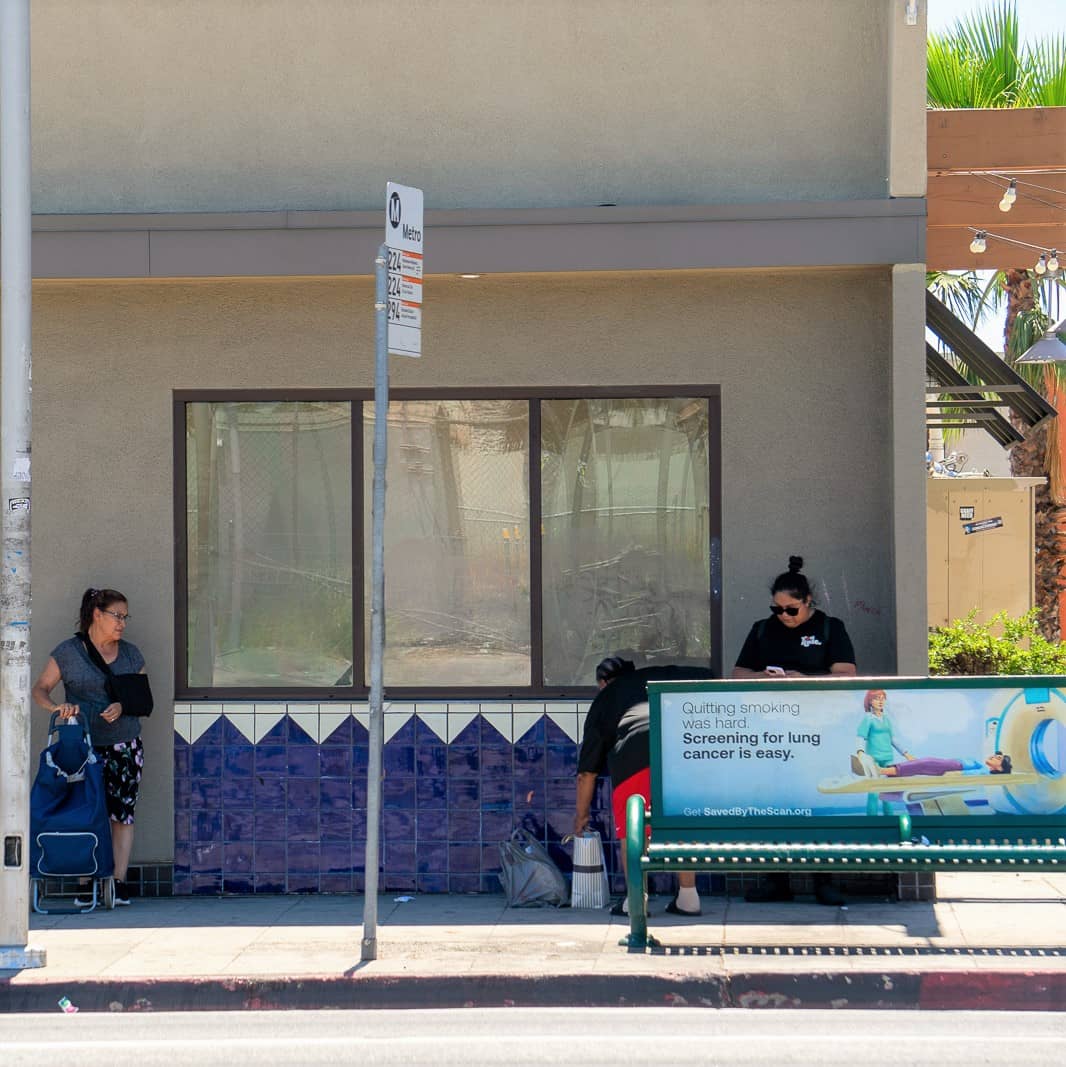
Built Environment
Riders seek shade from the surrounding environment near the bus zone. Poles, walls, buildings nearby may offer some relief from direct sun and UV rays. These options are not guaranteed, functional, nor meant to be used as transit amenities.
Frequently Asked Questions
-
What is a ShadeBlade™?
The ShadeBlade is a vertical shade structure that rotates and easily blocks the sun throughout the day. Its primary purpose is to create maximum useful shade for transit riders waiting at their bus stops. It provides an efficient and scalable solution for a systemwide rollout. It brings shade equity closer to reality.
With its opaque design and smooth weighted rotation system, it effectively blocks out direct sun rays and creates shade exactly where the passengers need it. The ShadeBlade can accommodate dozens of transit riders at a bus stop throughout the day (1 to 10 passengers per hour). It works well alone and in conjunction with mature trees, traditional bus shelters and the built environment.
The ShadeBlade creates useful shade all day long.
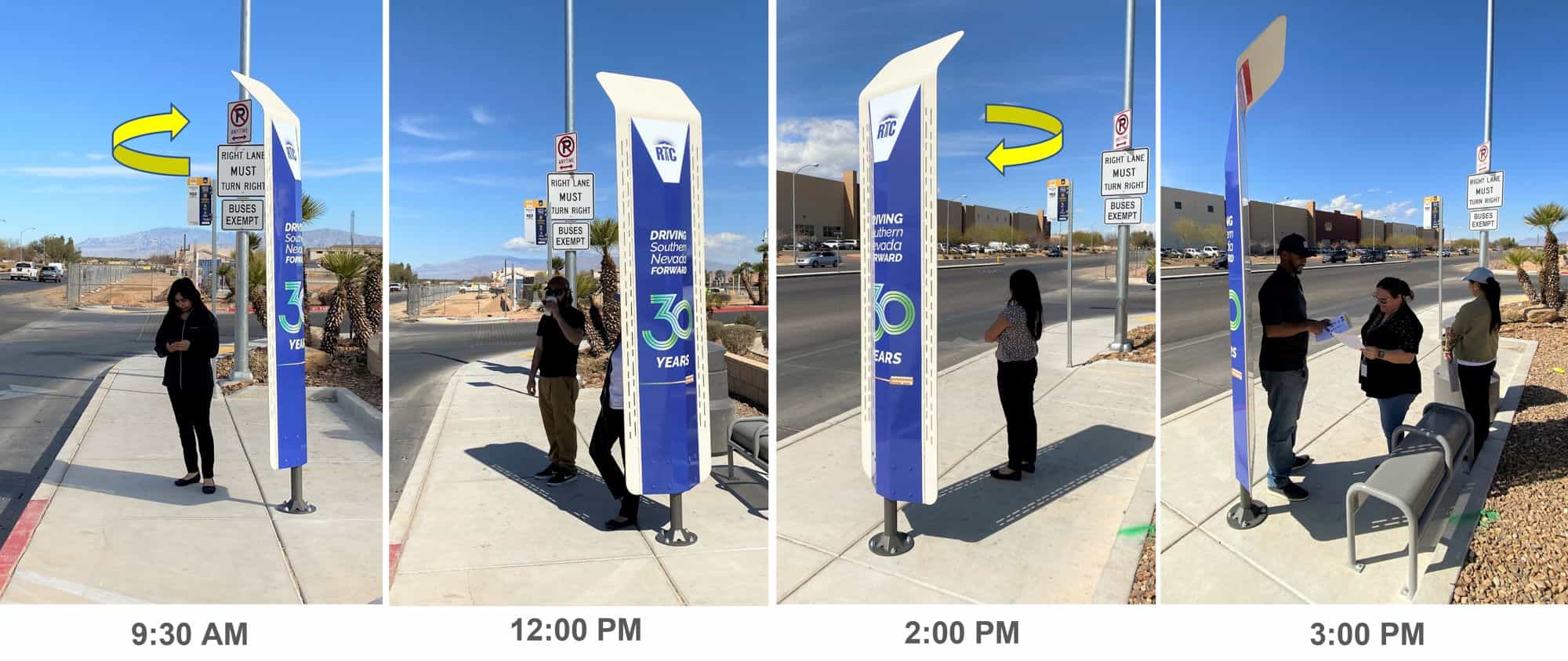
-
What are the benefits of a ShadeBlade?
The ShadeBlade creates instant useful shade beneficial for commuters. Transit agencies and municipalities have an opportunity to serve their commuters equitably and improve the well-being of transit riders within their service areas.
Transit riders benefit from the ShadeBlade because they receive:
-
Immediate shade while waiting at their bus stops at all hours of the day.
-
Protection from direct heat and UV sun exposure reducing heat-related health risks.
-
Enhanced bus stops infrastructure for a better transit system.
Useful shade, seating, and protection from UV rays make all the difference in a transit rider's journey.
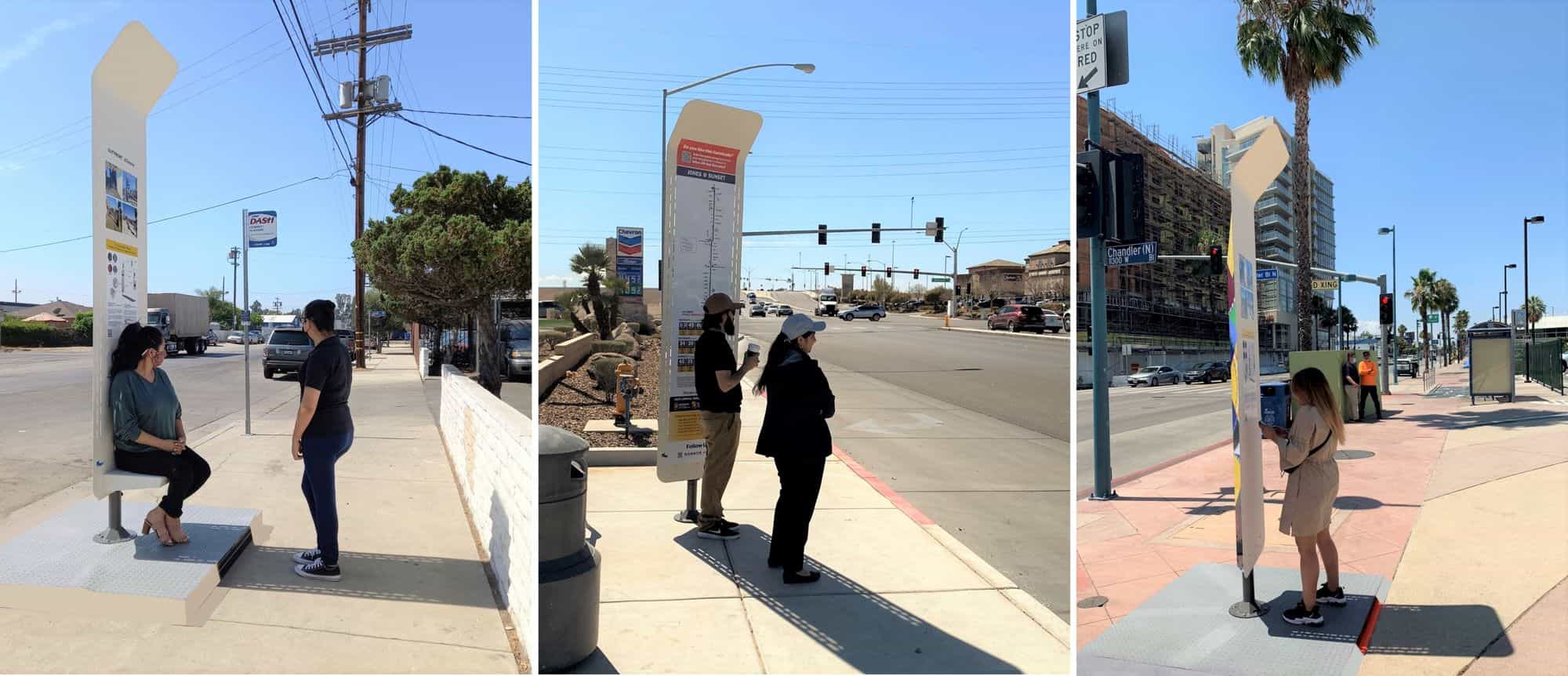
-
-
What are useful shade hours at bus stops?
Useful shade hours are the actual number of hours per day that passengers can access shade at a bus stop to protect themselves from the sun. It is not uncommon for transit riders to experience waiting at a bus stop with inaccessible shade, such as shade that falls on the street or private property.
Sun path simulations and real-world observations demonstrate that the number of useful shade hours at a bus stop can vary depending on two things: the type of transit amenity structure (if any) and the time of day/sun angle.
Examples of useful shade hour variation from horizontal/vertical shade structure.
The ShadeBlade offers the most useful shade at all hours of the day for transit riders, followed by traditional bus shelters; both can also include optional upgrades amenities such as seating and lighting.
This information is important for transit planners and policymakers who are working toward shade equity and improving the comfort of transit riders. More useful shade hours at bus stops reduce the risk of heat-related illness and encourage public transportation ridership.
-
Why is a ShadeBlade essential for a transit rider system?
Massive lack of shade for public transit riders at bus stops
According to the Washington Post, “Less than one-fifth [20%] of more than 122,000 bus stops served by 16 of the nation’s largest transit agencies have shelters”..
That accounts for millions of transit riders negatively impacted weekly!
The ShadeBlade offers shade equity to transit riders across the entire system regardless of gender, age, location, and socioeconomic status.
Source: Bus Shelter to Bus Stop Ratio-The Washington Post
A large majority of bus stops within a system remain without shade or amenities for commuters.
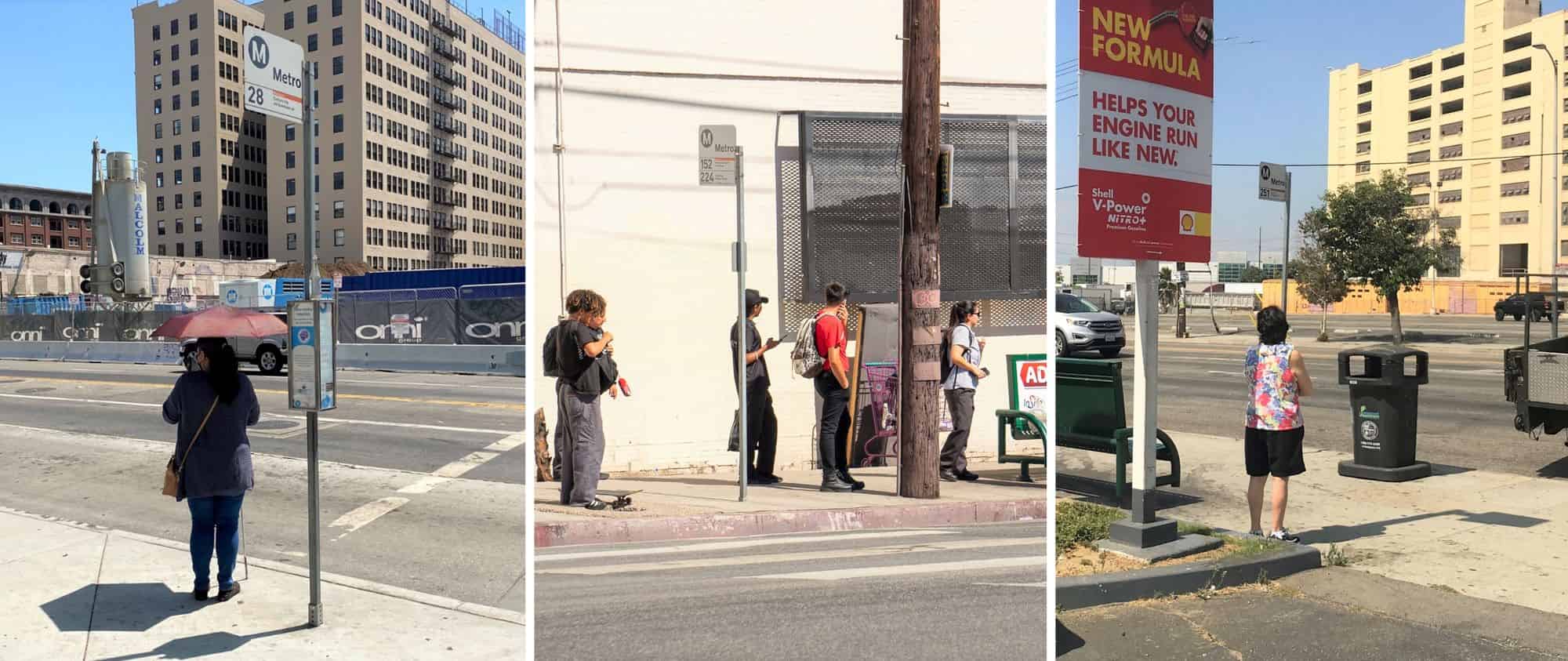
To see more examples, click here.
Public Health Risks for Passengers
The absence of shade at bus stops is a public health risk.
Heat and direct UV exposure pose detrimental effects on the health of transit riders, leading to heat-related illnesses such as heat stroke or skin cancer. These conditions can cause significant harm to an individual's overall well-being, as stated by the Centers for Disease Control and Prevention (CDC) in their article on Warning Signs and Symptoms of Heat-Related Illness.
Source: CDC | Extreme Heat Precautions
Climate Action Strategy
With continued growth of urban heat islands and hotter days year-round, there is a need to deliver useful and effective shade to transit riders at bus stops as equitably as possible systemwide. The ShadeBlade’s simple design and installation process helps transit agencies and cities with their climate change mitigation strategy goals.
Source: Heat Island Effect | US EPA
Encourages Public Transportation
By making the waiting experience at bus stops more pleasant and safe, transit agencies and municipalities encourage people to use public transportation with dignified bus stops. The ShadeBlade is an interactive and engaging transit amenity that users can easily adjust to create their own instant cooling effect.
By enhancing the waiting experience, we can increase public transit trips, which has a direct positive effect on reducing traffic congestion and individual car CO2 emissions.
Source: Public Transportation's Role in Reducing Greenhouse Gas Emissions (dot.gov)
-
Will the Shade Blade replace current bus shelters or trees?
Short answer: No. But it is very complimentary to both.
The ShadeBlade is designed for transit riders; it provides immediate useful shade relief to passengers who currently face shade inequity. It is a cost-efficient design; a smart transit infrastructure solution built for an easy rollout.
Natural trees and bus shelters are immensely beneficial, but the issue at hand is more complex and urgent than just planning on planting trees or installing bus shelters at every bus stop.
We understand that:
-
Transit agencies and cities face the challenge of managing thousands of bus stops, most have fairly low boarding counts (but all combined they represent millions of passengers a week), and it is evident that most bus stops (approximately 80%) are not consistently shaded with shade amenities.
-
Logistically speaking, sidewalks are not built equally. Tree initiatives and bus shelter installations are long-term solutions that require an ongoing maintenance program, significant initial capital investments, and ongoing annual funding, not to mention that not every sidewalk can physically accommodate these options.
A system-wide solution is necessary to create useful shade for commuters efficiently. This is where the ShadeBlade comes into play. The ShadeBlade is an innovative design that effectively addresses this lack of shade issue and ensures the provision of equitable shade for everyone.
The ShadeBlade works in collaboration with ALL shade equity efforts by serving all transit riders.
-
-
Understanding the science behind Shade Formation
Shade is a simple concept, yet intentional, useful shade creation can be complex to control and understand. There are several important factors to keep in mind when looking into the science behind shade creation:
-
A shadow is created when a physical structure obstructs sunlight. The position and size of the shadow are determined by the angle at which the physical object (vertical/horizontal) is positioned in relation to the sun, which constantly moves across the sky throughout the day.
-
The angular positioning of the sun is of utmost importance when it comes to creating useful shade, as it directly influences the shade size, shape, and direction. The position of the sun in the sky varies throughout the day, year-round meaning that a single traditional fixed shade structure design (i.e.horizontal roof) will not create the most useful shade for all hours of the day.
Source: Shade Formation and Position of the Sun |Science Learning Hub, Interactive Sun Path Simulation, Sun Path-Wikipedia
At times, shade is inaccessible (not useful) as it travels away from the waiting area.
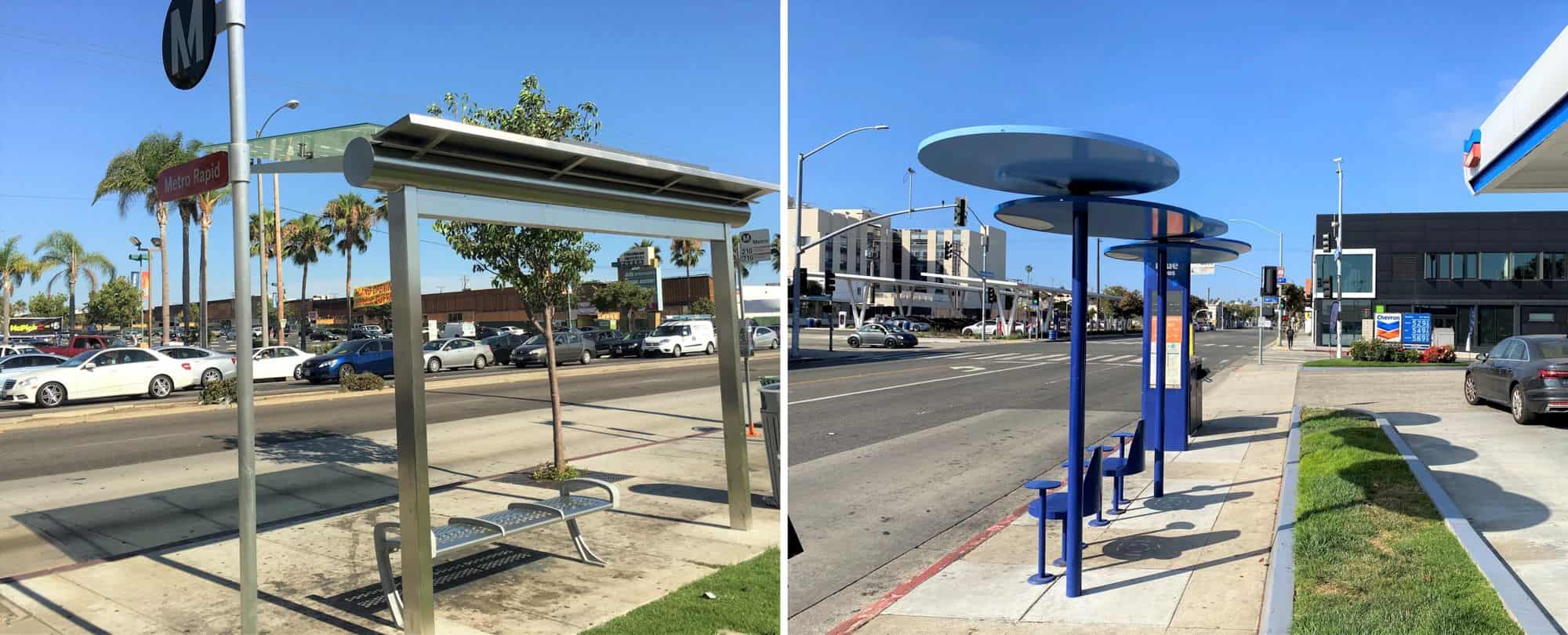
To see more examples, click here .
Useful Shade is complex to execute at all bus stops.
For real life field bus stops applications, here are some of the key elements to take into consideration:
-
How many hours of useful shade do you want to create for transit riders at a bus stop?
-
The movement of the sun across the sky and the sunray’s angles throughout the hours of day, year-round.
-
The strategic placement of a shade structure on the sidewalk to effectively shield against the sun's rays all day.
-
The orientation of the street and the location of a bus stop in relation to the cardinal directions (North, South, East, West).
-
The existing built environment, trees, buildings, poles, vaults, barriers, etc., surrounding the bus stop zone.
-
Understand the local urban heat island effects and how they impact transit riders in a transit system.
-
The number of passengers using a bus stop per day and per hour.
-
The sidewalk’s existing physical condition for an installation.
-
Alternative shade structure options for providing useful shade at a bus stop quickly and efficiently.
While a conventional horizontal roof offers excellent shade during summer midday hours when the sun is almost directly overhead, it provides less useful shade during the summer morning and afternoon hours and the rest of the year because of the angular positioning of the sun, whereas the vertical ShadeBlade maximizes shade creation at all hours of the day because it blocks and moves with the sun all year round.
Shade creation constantly varies throughout the day.
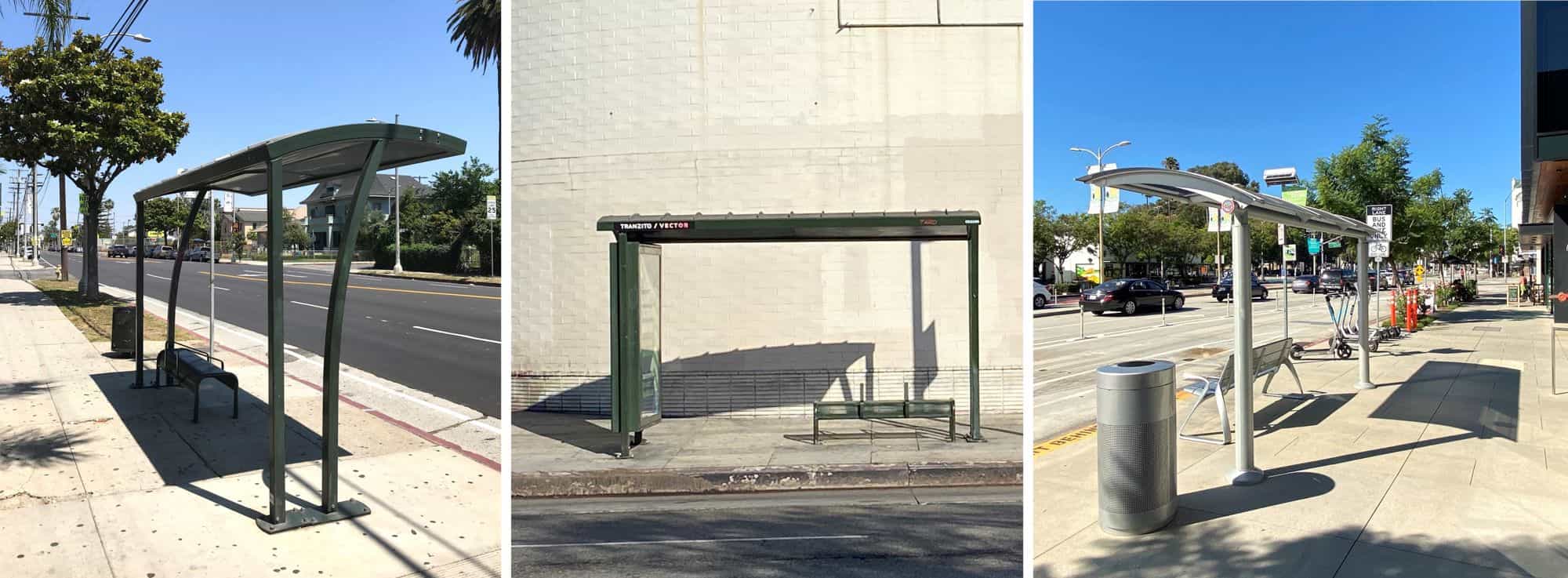
To see more examples, click here .
-
-
Why a vertical shade structure design?
Our intention is to create the most effective solution to produce shade at bus stops.
The ShadeBlade concept came in 2 steps:
-
We saw firsthand the complexity of creating useful shade. We learned from community interactions and real-life experiences at bus stops.
-
We studied the science of shadow formation. How does the ever-changing sun’s position in the sky and sun rays interact with static horizontal and/or vertical shade elements on sidewalks?
Through that journey and learning process, we were able to connect the dots from our real-life experiences waiting at bus stops, field observations, and research. Since 2018, we sought out various perspectives from conversations with transit riders, transit activists, academics, journalists, community-based organizations, transit professionals and city officials. These interactions and the science behind shade formation proved that a rotating vertical shade structure works best for creating shade throughout the day. With our in-house team and minimalist techniques, we aimed to produce a simple, yet efficient design that can be scaled across transit systems. The ShadeBlade is an intentional transit shade amenity that serves people while they wait for their bus.
Fun facts we learned during our Los Angeles research:
-
Los Angeles has an average of 3,348 hours of sunlight per year.
-
It is sunny 76.4% of daylight hours.
-
The sun is at its peak/zenith on June 21st and the sun angle is at 79 degrees.
-
Annually, at midday, the sun is on average at a 56 degree angle above the horizon.
Source: Sunrise, sunset, solar noon, day length and sun map for Los Angeles, USA (geotimedate.org)
-
-
How to choose between a Bus Shelter or a ShadeBlade?
First you must consider if shade equity aligns with your overall goals.
Second, consider how many hours per day of useful shade you would like to provide to your customers.
Approximately only 20% of bus stops have shade structures, 80% of bus stops are overdue for shade structures. Therefore, in addition to traditional bus shelters, the ShadeBlade can fill the gaps for 80% of bus stop locations and its passengers.
The ShadeBlade adapts to various bus stop sidewalk contexts, but not all bus stops can accommodate a bus shelter due to sidewalk limitations. Some shade options are easier in regard to funding, procurement, permitting and construction processes.
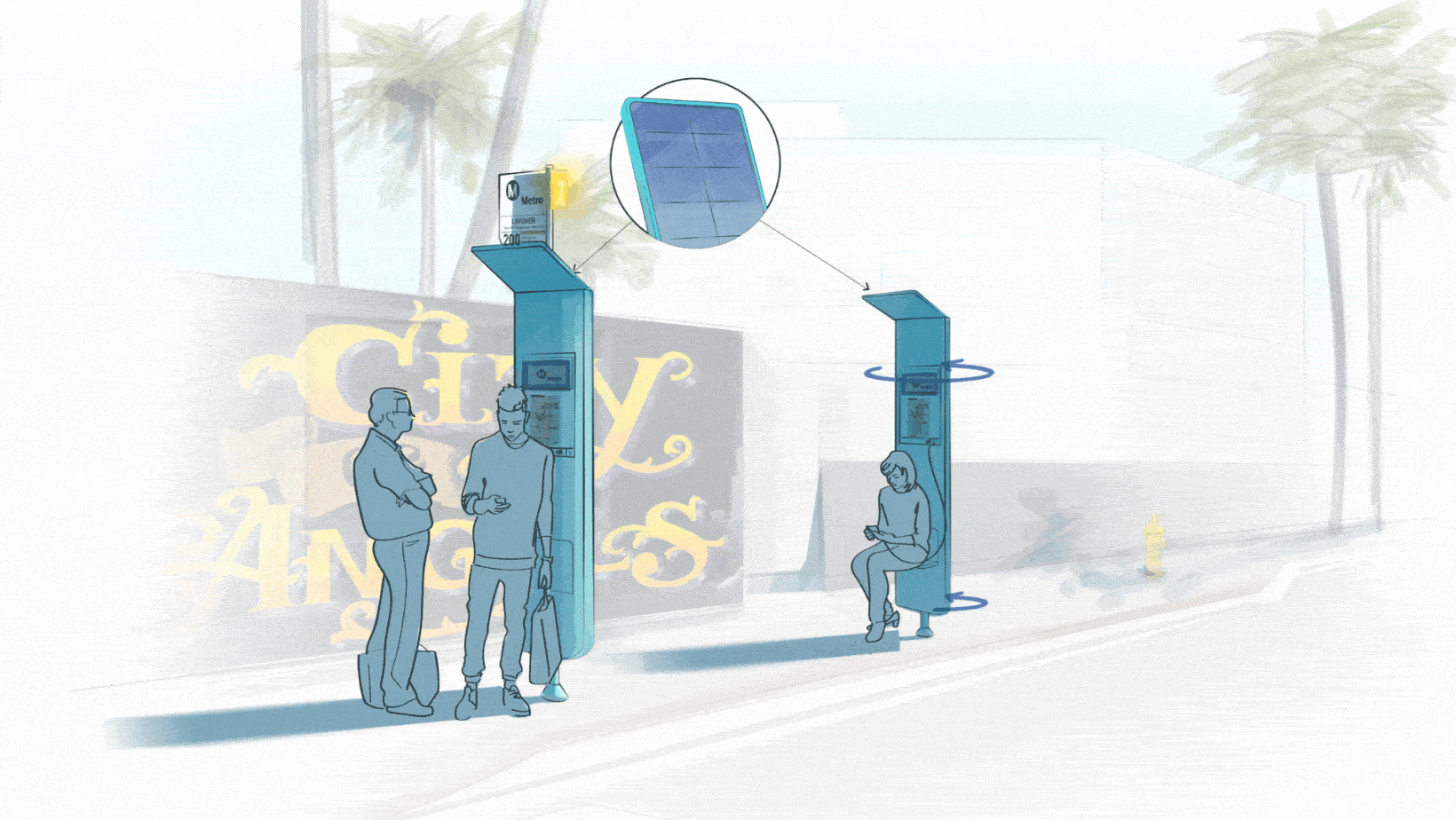
-
How does it work for high-traffic bus stops?
The ShadeBlade works very well at every bus stop. You can install multiple ShadeBlades as needed to protect more passengers, and it complements existing bus shelters, natural shade features and the built environment. The ShadeBlade works well for bus stops with 1-10 passengers per hour.
The ShadeShelter™ combines the benefits of bus shelters roof with the vertical ShadeBlade rotation since it provides shade relief and prioritizes the comfort and well-being of commuters at all hours regardless of the sun’s angle. The design can easily be adjusted to include 3, 5 or more ShadeBlades under an extended roof and serve dozens of transit riders at once.
-
ShadeBlade Technical Specifications
The ShadeBlade is easy to install and customize to transit agency and municipal specifications.
General description (may vary):
-
Steel metal or wood or combination
-
A customized engineered rotating mechanism
-
Weighted design on a smooth rotating axis
-
Cooling paint feature
-
Overall dimensions: H ~9ft x W ~2ft
-
Strategic perforation for visibility
-
Built-in adjustable block cap to limit rotations
-
User friendly, push-to-rotate system for personalized shade options
-
Easy to clean and maintain
-
Reduced carbon footprint element (less material to manufacture and maintain than bus shelters)
-
Cost-efficient structure
-
Customization options (design, size, shape, markers, color scheme, etc.)
Additional smart transit amenity features:
-
Seating attachment and lighting.
-
Bus stop signage and real-time transit information.
-
Solar panel attachments, Wi-Fi, and USB ports.
-
Community artwork and localized public service announcements.
Installation:
-
Quick and easy design for transportation, handling, and installation.
-
Less than 30 mins onsite installation
-
Anchored by bolts to existing concrete sidewalk
-
Reduced carbon-footprint (less time/labor).
-
Easy to relocate as needed.
The ShadeBlade is patented, U.S. Patent No. US 11,771,187 B2 & US 11,998,120 B2
-
The ShadeBlade is an innovative transit infrastructure that brings shade equity at bus stops closer to reality. It creates instant shade to improve the comfort and waiting experience of transit riders systemwide.
For real world shade solutions at bus stops, contact us!
ShadeBlade-info@jcdecaux.comThank you for using public transportation!
